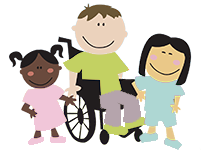Expressive and Receptive Language Disorders: What’s the Difference?
[vc_row][vc_column][vc_column_text] Every language disorder is one of two major types: expressive and receptive. Simply put, an expressive language disorder refers to difficulty with expressing meaning or messages to others. In contrast, a receptive language disorder refers to difficulty processing and understanding meaning and messages from others. However, it’s possible for children to have a mixed expressive-receptive disorder, exhibiting symptoms of both types of language disorders.
Every language disorder is one of two major types: expressive and receptive. Simply put, an expressive language disorder refers to difficulty with expressing meaning or messages to others. In contrast, a receptive language disorder refers to difficulty processing and understanding meaning and messages from others. However, it’s possible for children to have a mixed expressive-receptive disorder, exhibiting symptoms of both types of language disorders.
How are expressive and receptive language disorders treated?
Your child’s speech therapist will determine an individualized treatment plan for your child, depending on the following factors:
- Your child’s age
- Your child’s overall health and medical history
- The level of a swallowing disorder
- Your child’s tolerance for certain medications, therapies or procedures
- Expected health outcome of a swallowing disorder
- Opinions and preferences of family members
What are effective learning tools for children with language disorders?
There are countless ways to help your child learn to speak properly, including books, language disorder apps and experiential activities. However, the best learning tool for your child is your own knowledge about how to speak. When you speak to your child, exaggerate your facial movements and use other non-verbal clues that emphasize them.
In addition, your child’s speech therapist can recommend learning tools that have proven to be effective for the improvement of language disorders for those in your child’s age group.
How do I know if my child has an expressive or receptive language disorder?
In most cases, children with language disorders and delays struggle in both academic and social settings, which often results in behavioral problems. It’s important to catch delays as early as possible and seek the care of a speech therapist. Here are some symptoms you can look for if you believe your child may have a language disorder.
Receptive Language Disorders
- Difficulty processing and understanding what people are saying
- Difficulty following verbal directions
- Difficulty organizing thoughts for writing and speaking
Expressive Language Disorders
- Difficulty putting words together in the correct order to form sentences
- Difficulty choosing the correct words when speaking and may use ‘placeholder’ words like ‘um’.
- Limited vocabulary for the age group
- Omitting words from sentences
- Difficulty distinguishing between past, present and future tense.
While your child being diagnosed with a language disorder comes with many challenges, they are obstacles that can be successfully overcome with a solid network of healthcare providers, educators and therapists, as well as you and your child. If you’re concerned about your child’s language development, contact us at Speech and Occupational Therapy of Plano, Texas to schedule a consultation.[/vc_column_text][/vc_column][/vc_row]
